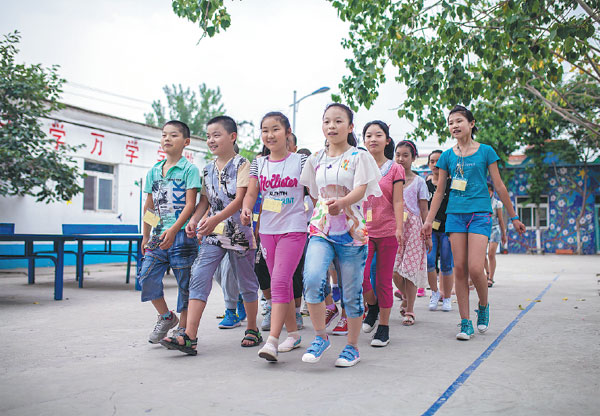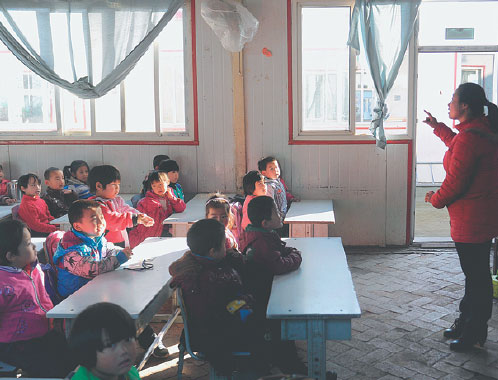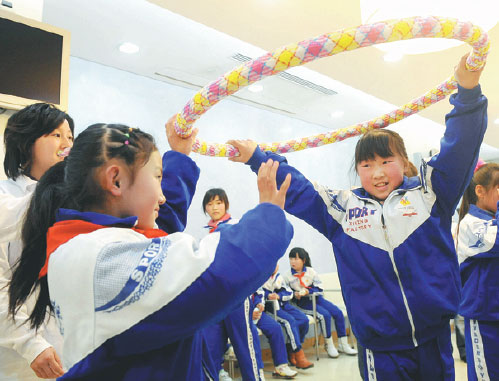Migrant children learn a tough lesson
Updated: 2016-02-25 08:23
By Wang Xiaodong and Zhao Xinying(China Daily USA)
|
||||||||
Population-control measures mean some big cities are making it increasingly difficult for the children of their least-privileged residents to enroll in the public school system, resulting in an exodus of students. Wang Xiaodong and Zhao Xinying report.
A long with Beijing's other primary and middle schools, the Dandelion School opened for a new semester on Tuesday. However, only 520 of the 549 registered students, all from migrant worker families, returned following the Spring Festival holiday, teacher Zhao Kai said.
"We learned that 23 students had transferred to other schools, mostly back in their hometowns, but the other six, mostly seventh-graders, did not return," Zhao said.
|
Students attend military training at Beijing's Dandelion School, a nonprofit institute for the children of migrant workers, in July. Zheng Liang / For China Daily |
|
A teacher and her students at Beijing Xingzhi Experiment School in November 2012. Yin Yafei / For China Daily |
|
Volunteers play games with students from Beijing Zhiquan School in December 2009. Yuan Zhou / For China Daily |
Founded in 2005, the school, which teaches grades seven through nine, is one of the few nonprofit educational establishments in the capital intended for the children of low-income migrant workers.
Zhao said it's becoming increasingly difficult for the students to enroll in Beijing's public high schools, which has resulted in some parents transferring their children to other areas before the end of their three years at the middle school in Daxing district.
Although the school always loses a few students at this time of year, Principal Zheng Hong fears that the number may decline further as conditions deteriorate in similar schools founded to educate children from poor migrant families.
"Years ago, some of our students could enroll in local high schools, but now it's becoming difficult for them to even gain admittance to Beijing's vocational schools," she said. "Last year, most of our graduates had to attend high schools in neighboring Beijing, such as Gu'an, Langfang and Yanjiao in Hebei province. For our graduates, the path to education is becoming narrower and narrower," she said. "Policies on schools such as ours are becoming tighter, and they keeping changing."
Qin Jijie, principal of Beijing Zhiquan School, also for migrant children, said the municipal government's policy of encouraging migrant workers to live in areas outside Beijing has had a big impact.
"In recent years, the number of schools like ours in Beijing has declined as student numbers have fallen," Qin said. "Inevitably, many of them will disappear."
Lack of opportunity
Children of migrant workers without hukou, or residence permits, have long experienced difficulty in gaining equal access to compulsory public education (grades one through nine) in large cities.
Parents must submit at least five different certificates, including documents confirming their work and home addresses, before their children can enroll in Beijing's schools.
Since 2014, many schools have required parents to submit a record of social security payments they have made in Beijing, a stipulation that some experts believe has further prevented most low-income migrant workers from sending their children to public schools.
Although many better-paid migrant workers without hukou choose to send their children to private schools, which charge more than public schools, that's not an option for people at the lower end of the scale.
According to a public consultation document released by the Beijing municipal government in December, migrant workers can apply for Beijing hukou based on "credits", including employment status, educational history and tax payments.
However, a number of basic requirements also have to be met; applicants must be no older than 45, and they must have paid social security contributions in Beijing for at least seven consecutive years.
The capital plans to cap the city's population at less than 23 million by 2030 to solve problems such as traffic congestion and air pollution. The current population is about 21.5 million.
In recent years, the authorities have implemented other measures, including moving low-end industries that employ large numbers of migrants, to neighboring Hebei to lower the population.
Even now, the Dandelion School is struggling to overcome difficulties such as a lack of funding. Its nonprofit status means teachers are paid less than their peers in public schools, resulting in regular departures.
According to Principal Zheng, as a nonprofit school for poor children, most of Dandelion's funding comes from donations from home and abroad. "The school has almost ground to a halt three times in the past 10 years," she said.
"Luckily every time we almost gave up, we were helped by our donors, so the school has survived," she said.
"I think Beijing needs more schools for the least-privileged children," she added. "They have no hukou, so they can't attend public schools, but they are poor so they can't go to expensive private schools either."
The students come from 24 provinces and autonomous regions, most of them underdeveloped, mountainous areas. Their parents are mostly uneducated, and work in construction or as vegetable vendors, she added.
Zhao, the teacher, said the school provides low-cost education for the students, who pay 3,400 ($520) a year for dorm fees, three meals a day, uniforms, insurance and tuition.
Ma Baohua, a 13-year-old seventh-grader from Baoding in Hebei, said that when she attended a private primary school for migrant children in Daxing, the dorm fees were more than 1,000 yuan a month, a huge sum for her single-income parents.
Gao Wan, an English teacher at the school, said she likes the students because they are polite and obedient, although their test scores are usually very low when they enroll. "Some can't even recognize all 26 letters of the English alphabet when they are admitted," she said. "However, many progress very quickly."
She said many students move to high schools in areas near Beijing, such as Gu'an and Langfang, while others attend vocational schools. She was unable to recall any who had been admitted to a high school in the capital.
Student numbers decline
Qin, of Beijing Zhiquan School, which was also founded to educate migrant workers' children, said many similar schools will close as more migrant workers leave the city.
The impact has been noticeable for several years, and student numbers have fallen to about 500 since 2014, when one of the school's two campuses was demolished for urban development.
"Students usually quit school before their parents leave Beijing," he said. "They return to their hometowns and continue their education while their parents make preparations to leave the capital."
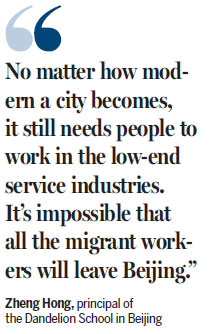
In the past two years, the stringent entry requirements have resulted in Qin's students finding it increasingly difficult to register with the compulsory education system, so most of the students at grades one and two are unregistered. That means most will be ineligible for enrollment in the capital's middle schools when the time comes, he said.
A report published by the 21st Century Business Herald said that in 2014 about 60,000 migrant children in Beijing's primary schools were unregistered, he said, adding that although the schools are getting bigger, the number has fallen to about 100 from nearly 500 in 2004.
Yi Benyao, principal of Xingzhi Experimental School in the Haidian district, said the students are finding it much harder to register in Beijing, and the number of schools for migrant children has declined at a "dramatic rate" in recent years as a result of demolition programs and the transfer of migrant workers to areas near the capital.
Xiong Bingqi, vice-president of the 21st Century Education Research Institute in Beijing, has spent many years conducting research into the education of migrant children. He said the entry requirements in urban schools nationwide were progressively eased from 2008, when the central government released policies to allow migrant children to be educated in the cities in which their parents worked.
However, in the past few years, the admission policies have been tightened again. Guidelines released by the Beijing Municipal Commission of Education in 2012 stipulated that students without Beijing hukou, including those from migrant families, must provide five documents to be admitted for compulsory education in the capital.
In theory, five documents, including the parents' temporary residence permits and work permits, should be sufficient, but in reality parents often have to submit many more - sometimes as many as 28 - and sometimes it can take years to assemble the required paperwork.
Xiong believes the tightened policies are the result of population-control programs in cities such as Beijing and Shanghai, which are concerned that they may be flooded by migrants if the enrollment threshold is lowered, thus increasing the burden.
Chu Zhaohui, a senior researcher at the National Institute of Education Sciences, said national education policies stipulate that local governments should pay students' fees during the period of compulsory primary and junior middle school education, and financial pressures mean many urban schools are reluctant to accept migrant children.
"However, if the children follow their parents to a city in a different province and receive compulsory education there, the government of the city in which they reside is obliged to bear the expense, rather than the city they came from. So, to avoid great financial pressure, these cities have raised the entry bar to control the number of migrant children who enroll," Chu said.
'Portable' expenses
He suggested making compulsory education expenses "portable" to solve the problem.
"In this way, the inflow of migrant children won't pose great challenges for local governments, and these cities will become more open to migrant children."
The central government has already made moves in this direction. According to a notice released by the State Council, China's cabinet, in December, a unified national standard will be established to cover the cost of compulsory education, and the authorities will ensure that schools are reimbursed, no matter where the students live and study.
However, Xiong believes that a move away from controlling population numbers by restricting children's educational opportunities could be an equally effective measure. "Irrespective of the solution, we must ensure that every child has the right to receive compulsory education," he said.
Qin said that in the past two years Beijing Zhiquan School has made efforts to reverse the decline in student numbers. It has started classes about traditional Chinese culture, and many of the attendees are children from higher-income white-collar families. "Many of these schools will either have to change or die," he said.
Zheng, of the Dandelion School, said the departure of some of the migrant workers would not have a significant impact on the school: "No matter how modern a city becomes, it still needs people to work in the low-end service industries. It's impossible that all the migrant workers will leave Beijing."
By the end of the year, with the aid of donors and the local government, the school will move to a new 1-hectare site near its current premises that will accommodate more than 800 students in 18 classes, compared with about 500 now.
"Our goal hasn't changed - we will continue to provide quality education for children from the poorest families," she said.
Contact the writers at wangxiaodong@chinadaily.com.cn
(China Daily USA 02/25/2016 page6)
- Obama makes last attempt to persuade Congress to close Guantanamo
- Over 110,000 refugees, migrants reach EU by sea
- DPRK warns to use weapons against US-ROK forces
- Trump's third straight win has rivals looking for answers
- Suicide bomber behind Ankara attack identified
- Cuba to deploy 9,000 troops to prevent Zika virus
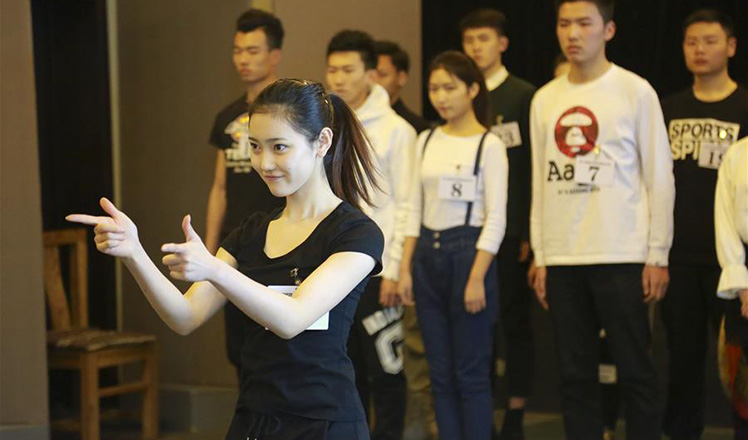
 Future stars battle intense competition for stardom
Future stars battle intense competition for stardom
 Cuties around the world celebrate Chinese New Year
Cuties around the world celebrate Chinese New Year
 Young woman's businesses thrive in rural Jilin
Young woman's businesses thrive in rural Jilin
 Seven-year-old village kid cares for her grandparents
Seven-year-old village kid cares for her grandparents
 Matters of state
Matters of state
 Students begin new term with lucky bags and red envelopes
Students begin new term with lucky bags and red envelopes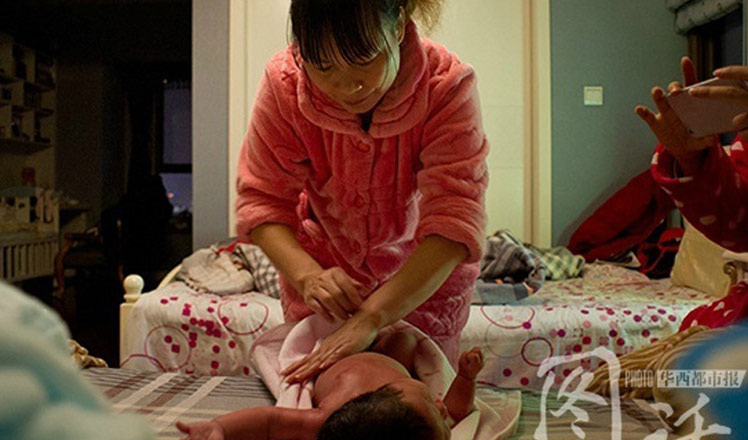
 The life of a postpartum care worker
The life of a postpartum care worker
 Top 10 most Internet-savvy banks in China
Top 10 most Internet-savvy banks in China
Most Viewed
Editor's Picks

|

|

|

|

|

|
Today's Top News
What ends Jeb Bush's White House hopes
Investigation for Nicolas's campaign
Will US-ASEAN meeting be good for region?
Accentuate the positive in Sino-US relations
Dangerous games on peninsula will have no winner
National Art Museum showing 400 puppets in new exhibition
Finest Chinese porcelains expected to fetch over $28 million
Monkey portraits by Chinese ink painting masters
US Weekly

|

|
